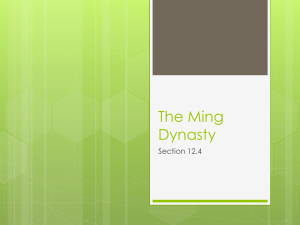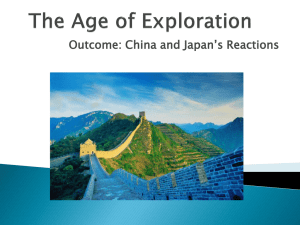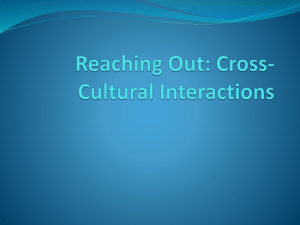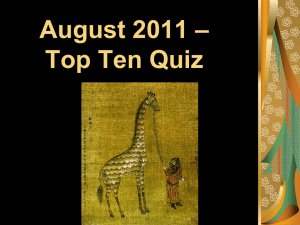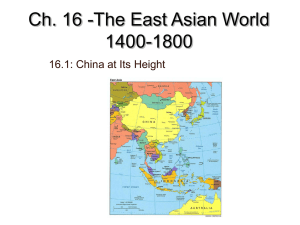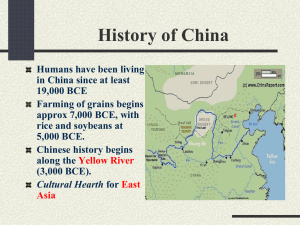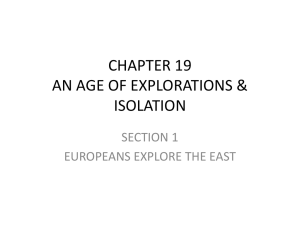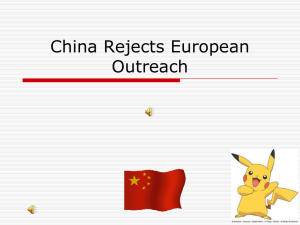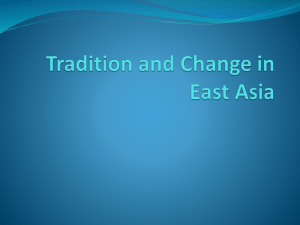File - Mrs. Stoll
advertisement
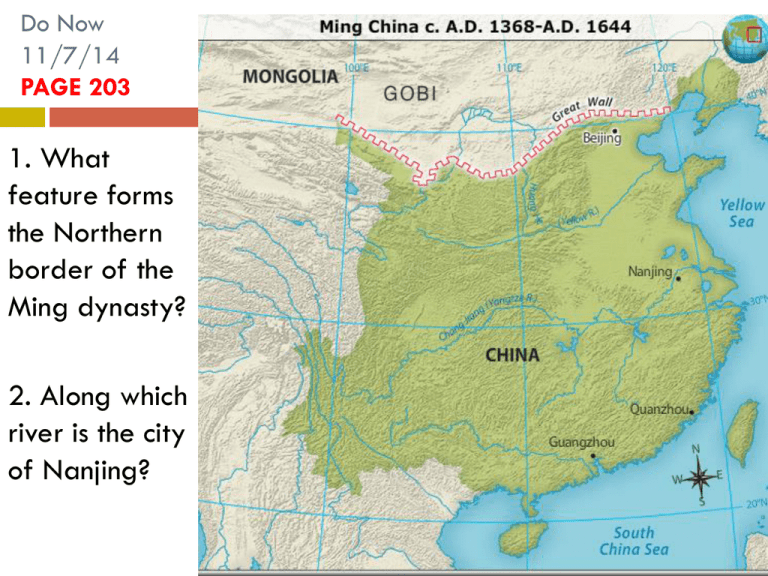
Do Now 11/7/14 PAGE 203 1. What feature forms the Northern border of the Ming dynasty? 2. Along which river is the city of Nanjing? The Ming Dynasty McGraw-Hill Connect ED CHAPTER 8 LESSON 4 THE MING DYNASTY Mrs. Stoll 7th Grade Social Studies The Rise of the Ming Civil unrest ended the Mongol rule A.D. 1368, military officer, Zhu Yuanzhang (Joo Ywahn Jahng) became emperor Reunited the country and founded the Ming dynasty in his capital city of Nanjing (Nan Jihng) in southern China. Ruled for 300 years. The Rise of the Ming Zhu took the name Hong Wu (Hahng Woo) or the “military emperor” Brought peace and order Harsh ruler; trusted few people and punished officials suspected of treason, or disloyalty to the government. A.D. 1398, his son became emperor and took the name Yong Le The Rise of the Ming Yong Lee moved the capital city north to Beijing Built the Imperial City, large area of palaces and government buildings Forbidden City, where the emperor and his family lived, only top government officials were allowed to enter. The Forbidden City –Video Segment Discovery Education How did the Ming Change China? Emperors brought back the civil service examinations One job of government official was to carry out a census- or a count of the number of people in China. Census helped to identify who owed taxes. How did the Ming Change China? Strong government of early Ming emperors provided peace and security As a result, the economy grew Rebuilt canals, farms, roads, and planted new forests Expanded the Grand Canal which increased trade between southern and northern China Ming dynasty also supported the silk and cotton industries Arts and Literature Printed novels and theater flourished during the Ming dynasty The Romance of the Three Kingdoms most popular novel Many novels were written in vernacular, or everyday language; formal language was avoided Traditional Chinese dramas were banned during the Mongol rule, but restored under the Ming rule Chinese Exploration Early Ming emperors wanted to explore the world and expand Chinese influence Built large fleet of ships, known as junks, traveled along the coast of China Between A.D. 1405 and 1433 Chinese fleets went on seven sea voyages. They wanted to trade with other kingdoms and demand that weaker kingdoms pay tribute to China Junks Chinese Exploration Leader of the voyages was a Chinese Muslim and court official named Zheng He (Jung Huh) The Travels of Zheng He First fleet to Southeast Asia Later reached western coast of India and the city-states of East Africa Brought back giraffes and other African animals Encouraged Chinese merchants to settle in Southeast Asia and India and spread Chinese culture Travels of Zheng He Despite the benefits, Chinese officials complained that the ongoing trips cost too much money and would introduce unwanted foreign ideas Some officials also believed being a merchant was a selfish and unworthy occupation A Confucian teaching said that people should place loyalty to society ahead of their own desires. Travels of Zheng He Zheng He’s death in A.D. 1433 marked the end of the sea voyages. Ships were taken apart and trade with other countries sharply declined Within 50 years, Chinese shipbuilding technology became outdated. Arrival of Europeans In A.D. 1514, ships from Portugal arrived off the coast of southern China Portuguese wanted to trade with China and convert them to Christianity To the Chinese, the Europeans were barbarians, or uncivilized people Arrival of Europeans At first, local officials refused to trade with the Portuguese By A.D. 1600 the Portuguese established a trading post in the port of Macao (muh KAU) in southern China Portuguese ships carried goods between China and Japan Trade between Europe and China remained limited Arrival of Europeans Despite limited contact European ideas did reach China Christian missionaries made the voyage to China on European merchant ships Many of these missionaries were Jesuits, a group of Roman Catholic priests. Arrival of Europeans Jesuits were highly educated and hoped to establish Christian schools in China Their knowledge of science impressed Chinese officials However, they did not convince many Chinese to convert to Christianity The Fall of the Ming After a long period of growth the Ming dynasty began to weaken Dishonest officials took over the country Placed heavy taxes on farmers and the farmers revolted As the dynasty began to crumble, the Manchuspeople from the north prepared to invade. The Fall of the Ming Like the Chinese, the Manchus had been conquered by the Mongols They retreated to an area northeast of China’s Great Wall, known today as Manchuria The Manchus defeated the Chinese armies and captured Beijing In A.D. 1644 they established a new dynasty named the Qing (CHEENG) dynasty Review Questions Answer questions # 1-5 on page 207 Use complete sentences and evidence from the textbook

